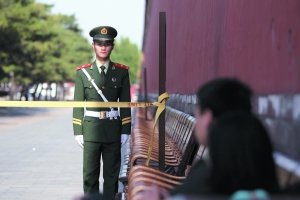More scandals at museum
 0 Comment(s)
0 Comment(s) Print
Print E-mail
China Daily, August 8, 2011
E-mail
China Daily, August 8, 2011

After the damage to a precious porcelain artifact was exposed late last month, the credibility of the Palace Museum in Beijing was already in tatters. But now the public is demanding clarification about other incidents.
Netizens found five famous calligraphies of the Song Dynasty (960-1279), which were supposed to be part of the Palace Museum's collection, had been auctioned. The micro-bloggers criticized the caretaker of the country's treasures for raising money by selling these pieces of art.
The museum denied that the five treasured items were in its collection, but its spokesperson admitted that an investigation was underway into an allegation that the museum had covered up four more incidents in which major relics were damaged.
The museum made a hasty response when a netizen disclosed that a researcher had broken a valuable Ge kiln ceramic from the Song dynasty earlier last month, having sat on the news for almost four weeks, clearly hoping to cover it up.
The damage is a great loss to the country's relics. But the museum's attempted cover-up is more serious than the damage. The museum's poor security was also revealed by a bungled art theft in May and further controversy was aroused by the museum authorities' intention to use the rebuilding opportunity to turn the institution's Jianfu Palace into a world-class private guesthouse accommodating only the wealthy.
All these mean there are serious doubts about the capability of the museum's governance and the management's ability to care for the national heritage under its care.
The museum is a caretaker of our cultural heritage. Its aim is to hold for the benefit and education of all a collection representative of Chinese culture and to ensure that the collection is housed in safety, conserved, curated, researched and exhibited.
Clearly the museum has let us down.
When several books of the Complete Library in the Four Branches of Literature compiled in 1772-1782 at the order of Emperor Qianlong (1376-1795) were found soaked with rain in Taiwan in 1963, the person responsible for taking care of the 2,972 crates of artifacts resigned.
However, the officials in Beijing's Palace Museum have clung on to their positions despite these scandals. In an apparent attempt to contain the damage done to its image, the Palace Museum in a statement said: "When faced with questions from the media, the relevant museum department failed to ask the higher authorities for instruction. They still persisted in their errors. This not only misled the public, but also did damage to the reputation of the entire Palace Museum."
Which is stating the obvious and leaves too many unanswered questions. By keeping its mouth shut, the country's premier museum merely invites more scrutiny.
The British Museum publishes its annual reports and accounts, and the minutes of its meetings online. The Palace Museum keeps its governance and management a forbidden land. This is not the right way to restore its reputation.





